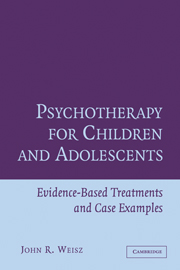Book contents
- Frontmatter
- Contents
- Preface
- SECTION A GENERAL INTRODUCTION
- SECTION B TREATMENTS FOR FEARS AND ANXIETY
- SECTION C TREATMENTS FOR DEPRESSION
- SECTION D TREATMENTS FOR ATTENTION DEFICIT/HYPERACTIVITY DISORDER
- SECTION E TREATMENTS FOR CONDUCT PROBLEMS AND CONDUCT DISORDER
- Introduction to Section E: The Case of Sal and Treatments for Conduct Problems and Conduct Disorder
- 8 Treating Conduct Problems by Teaching Anger Control
- 9 Behavioral Parent Training and Family Treatment for Conduct Problems
- 10 Parent-Child Interaction Treatments for Child Noncompliance
- 11 Parent Training through Video Modeling and Structured Group Discussion
- 12 Using Problem-Solving Skills Training and Parent Management Training for Children with Conduct Disorder
- 13 Multisystemic Therapy for Antisocial and Delinquent Youth
- SECTION F CONCLUSION
- References
- Author Index
- Subject Index
11 - Parent Training through Video Modeling and Structured Group Discussion
Published online by Cambridge University Press: 06 July 2010
- Frontmatter
- Contents
- Preface
- SECTION A GENERAL INTRODUCTION
- SECTION B TREATMENTS FOR FEARS AND ANXIETY
- SECTION C TREATMENTS FOR DEPRESSION
- SECTION D TREATMENTS FOR ATTENTION DEFICIT/HYPERACTIVITY DISORDER
- SECTION E TREATMENTS FOR CONDUCT PROBLEMS AND CONDUCT DISORDER
- Introduction to Section E: The Case of Sal and Treatments for Conduct Problems and Conduct Disorder
- 8 Treating Conduct Problems by Teaching Anger Control
- 9 Behavioral Parent Training and Family Treatment for Conduct Problems
- 10 Parent-Child Interaction Treatments for Child Noncompliance
- 11 Parent Training through Video Modeling and Structured Group Discussion
- 12 Using Problem-Solving Skills Training and Parent Management Training for Children with Conduct Disorder
- 13 Multisystemic Therapy for Antisocial and Delinquent Youth
- SECTION F CONCLUSION
- References
- Author Index
- Subject Index
Summary
Behavioral parent training is a potent treatment for child conduct problems, as discussed in Chapters 6, 9, and 10. For some therapists, though, the challenge of becoming a behavioral expert and finding time to structure individual interventions, one family at time, can discourage efforts to try behavioral approaches - particularly under the productivity pressures of managed care. Fortunately, there is a cost-effective approach that relieves therapist burden to some degree, and has unusually strong empirical support. The approach uses videotaped illustrations to convey behavioral principles through observational learning, one of the most efficient ways to build skills.
The most thoroughly tested video modeling approach has been developed by Webster-Stratton (e.g., 1981a,b, 2001) and her colleagues. In the parent component of their Incredible Years Training Series, a therapist shows brief videos of parent-child interactions to groups of mothers and fathers and leads discussions on themes illustrated in the videos. In this chapter, we describe some of the videos, some of the themes, and some of the evidence on treatment effects.
The Incredible Years BASIC Parent Training Program: Conceptual Basis and Procedural Overview
Advantages of teaching parents child behavior management skills were discussed in Chapter 9. Teaching parents via video illustrations may offer further advantages. One is that the video approach employs modeling, a highly efficient form of learning that outpaces, for example, the trial and error process involved in operant conditioning (see e.g., Bandura, 1971, 1986). The video-guided approach is also more engaging for many parents than didactic learning in a classroom format, or being required to read a book and take a test on it.
- Type
- Chapter
- Information
- Psychotherapy for Children and AdolescentsEvidence-Based Treatments and Case Examples, pp. 353 - 386Publisher: Cambridge University PressPrint publication year: 2004
- 3
- Cited by



